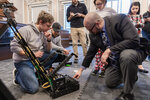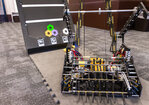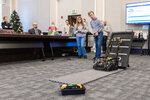





While basketball has advanced in the 130 years since Dr. James Naismith nailed two peach baskets to the walls of a YMCA gymnasium in Illinois, the same general premise of putting the ball into a basket remains unchanged.
Meanwhile, high school robotics teams across the country receive a new game and rules each September and have just two months to prepare.
“Which is not that much time in robotics,” Adna High School Senior Nate Scheuber said Tuesday morning.
In recent years, the objective of the competitions has included stacking cones and blocks and shooting rings. This year, the robots must pick up 3-inch hexagonal “pixels” on a 12-foot by 12-foot foam tile field and place them in different configurations on a board for points.
During the commissioners’ business meeting on Tuesday morning, Lewis County commissioners and staff were treated to a demonstration of the robot Scheuber and his fellow Adna High School robotics team members built for competitions.
“To give these kids (the opportunity) to learn about electronics and coding, which I think is just going to be a growing opportunity in the future, is just excellent,” Commissioner Lindsey Pollock said.
Part of the goal, the students said, is to inspire the next generation.
“We want the next generation kids to be interested in robotics since it’s such a big thing nowadays,” junior Phoebe Allen said. “We just really want everyone to know and enjoy the things that we also enjoy.”
Adna’s robotics program began about 10 years ago, when Superintendent Jim Forrest approached Marcy Scheuber about starting a robotics program in the district. In the years since, what began with miniature robotics kits known as VEX Robotics advanced to the Lego League, the level below where Adna currently competes.
“We did two years of that, and then in seventh grade we switched to FTC,” Nate Scheuber said “So it’s just kind of been a slow progression throughout the years.”
Adna still uses a practice rink in Marcy Scheuber’s third grade classroom, with team members tinkering and adjusting their design in between matches.
“It’s great to see forward thinking education that gets young people excited about technology that is shaping the future,” Commissioner Scott Brummer said. “I commend Adna for investing in these programs and the students for an outstanding job demonstrating their talents.”
As the lead designer, Nate Scheuber uses computed aided design (CAD) to pre-build the robot and design custom parts. The robot can cost between $2,000 and $2,500, funded through grants and sponsors.
Like a painter crafting a mural, the complete picture only becomes clear toward the end of the project.
“Our robots are very modular, so we will go from having literally nothing to having a completed robot in a day,” Nate Scheuber said. “That’s one of my favorite parts, because I design the robots, so seeing something come from the computer and bring it into the real world, is easily my favorite part.”
Another key difference between robotics and traditional high school sports is the wider range of competition the robotics team faces.
When the Adna High School basketball team suits up, they do so under the 2B classification of the Washington Interscholastic Athletic Association, which means the team faces schools with the same general student population.
The robotics team, though, is sanctioned through For Inspiration and Recognition of Science and Technology, which pits schools from across the state, and even some homeschooled clubs dubbed “community teams,” against each other.
The difference means a team like Adna, which has roughly 250 high school students, may face off against Bellevue High School, which has about 1,500.
But the Adna students aren’t phased.
“It’s really the passion of the kids that determines the winner at competition,” Nate Scheuber said.
And though they may not fully understand the intricacies of the robot design or the competition, Nate Scheuber said his classmates are supportive.
“I think my favorite part has to be the feeling after a match goes quite well,” Allen said. “Just that feeling of ‘we know that we did well.’ It doesn’t matter like, even if we lost, just knowing that we personally achieved something that we set our minds toward, just is a great feeling.”
The students are optimistic the program will continue to grow as Adna elementary and middle school STEM students progress to high school. The middle school team has about 20 members, compared to the four on the high school team.
“Their recent achievements are a testament to the incredible potential of our youth when they are given access to quality education in science and technology. Programs like this not only equip students with valuable skills but also inspire creativity and problem-solving abilities,” Commissioner Sean Swope said. “It’s initiatives like these that are essential in preparing our young people for future success in an increasingly tech-driven world. Congratulations to the team for their hard work and dedication.”
Part of the appeal for students, Scheuber said, is a lower barrier of entry. While a football player may need to buy new cleats, a mouthguard or other gear every year, the robotics team is free for students to join.
“It’s accessible,” Nate Scheuber said.
The Adna robotics team will participate in an interleague event at Olympia High School on Sunday, Jan. 14. It will begin around 11 a.m. The competition is free and open to the public.